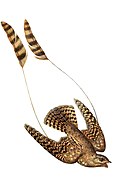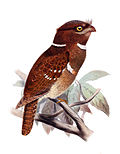Cypsiurus
| Cypsiurus | |
|---|---|

| |
| African palm swift | |
| Scientific classification | |
| Kingdom: | Animalia |
| Phylum: | Chordata |
| Class: | Aves |
| Clade: | Strisores |
| Order: | Apodiformes |
| Family: | Apodidae |
| Tribe: | Apodini |
| Genus: | Cypsiurus Lesson, 1843 |
| Type species | |
| Cypselus ambrosiacus[2] Temminck, 1828
| |
| Species[1] | |
| |
Cypsiurus is a genus of birds in the swift family Apodidae. It includes three species, which were formerly considered to be conspecific due to their similarity.
Species
[edit]| Common name | Scientific name and subspecies | Range | IUCN status and estimated population |
|---|---|---|---|
| Asian palm swift | Cypsiurus balasiensis (Gray, 1829) Four subspecies
|
Widespread throughout Asia | LC [3]
|
| African palm swift | Cypsiurus parvus (Lichtenstein, 1823) Six subspecies
|
Widespread throughout Africa | LC [4]
|
| Malagasy palm swift
|
Cypsiurus gracilis (Sharpe, 1871) Two subspecies
|
Madagascar and the Comoros | LC [5]
|
Description
[edit]They have mainly pale brown plumage and long swept-back wings that resemble a crescent or a boomerang. The body is slender, and the tail is long and deeply forked, although it is usually held closed. The sexes are similar, and young birds differ from adults mainly in their shorter tails. Palm swifts have very short legs which they use only for clinging to vertical surfaces, since swifts never settle voluntarily on the ground.[citation needed]
These swifts spend most of their lives in the air, living on flying insects. Palm swifts often feed near the ground, and they drink on the wing.[citation needed]
References
[edit]- ^ Gill, Frank; Donsker, David; Rasmussen, Pamela C., eds. (2025). "Owlet-nightjars, treeswifts, swifts". IOC World Bird List. Version 15.1. Retrieved 15 October 2025.
- ^ "Apodidae". aviansystematics.org. The Trust for Avian Systematics. Retrieved 23 June 2025.
- ^ BirdLife International (2024). "Cypsiurus balasiensis". IUCN Red List of Threatened Species. 2024 e.T22686769A263634776. doi:10.2305/IUCN.UK.2024-2.RLTS.T22686769A263634776.en. Retrieved 15 October 2025.
- ^ BirdLife International (2019). "Cypsiurus parvus". IUCN Red List of Threatened Species. 2019 e.T155257123A155636301. doi:10.2305/IUCN.UK.2019-3.RLTS.T155257123A155636301.en. Retrieved 15 October 2025.
- ^ BirdLife International (2019). "Cypsiurus gracilis". IUCN Red List of Threatened Species. 2019 e.T155257132A155636758. doi:10.2305/IUCN.UK.2019-3.RLTS.T155257132A155636758.en. Retrieved 15 October 2025.
- Barlow, Wacher and Disley, Birds of The Gambia ISBN 1-873403-32-1
- Chantler and Driessens, Swifts ISBN 1-873403-83-6
- Grimmett, Inskipp and Inskipp, Birds of India ISBN 0-691-04910-6









